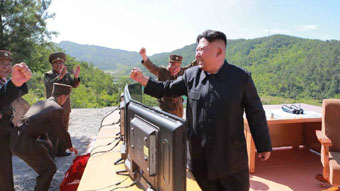
Kim Jong-un celebrates Friday's launch with staff and generals/
image North Korean media
ICBM Test:
North Korea’s Most
Sophisticated to Date
| published August 1, 2017 |
By Keith H. Roberts, Thursday Review contributor
On Monday, Pentagon officials confirmed what independent military analysts have suggested for days: North Korea’s Friday test of its second fully-developed ICBM was the rogue nation’s most sophisticated rocket launch yet, and that the missile spent more time at high altitude than any previous test launch by Pyongyang.
According to several military sources who have analyzed the data, Friday’s ICBM test carried the rocket roughly 2,000 miles into space, or 600 miles higher than its previous July launch. Designated KN-21 ICBM by the U.S. Defense Department, the two-stage rocket remained aloft for more than 45 minutes—the longest such flight in North Korean history.
Military and aerospace experts who have analyzed the video footage and the data from the Friday launch have said that the missile—if fired along a more horizontal trajectory—would have the capacity to hit targets across at least half of the continental United States, meaning that Kansas City, St. Louis and Dallas would be within range of North Korea missiles.
Though monitored by intelligence and military components in South Korea, Japan and the U.S., North Korean media announced the ICBM test only minutes after the multi-stage rocket descended and splashed down into the waters off the west coast of Japan. This was Pyongyang’s second such launch in less than one month.
As was the case earlier in July, in the hours and days after North Korea’s previous ICBM test launch, the U.S. and South Korea also conducted drills to test readiness for possible future missile attacks by Pyongyang.
And in a massive show of force, and in direct response to the two recent tests of ICBMs, the United States and South Korea staged high profile demonstrations of military power over the weekend—exercises which included the test firing of ground-launched anti-ICBM rockets, and high speed flyovers using state-of-the-art B-1B bombers. The two U.S. supersonic B-1B bombers took off from a base in Guam, traversed the western Pacific, and were joined by fighter and escort jets of Japan and South Korea. The bombers and their escorts flew across the Korean peninsula well with radar range of North Korean air defenses.
On Sunday, U.S. Senator Diane Feinstein (D-CA) told reporters that North Korea’s missile program has moved more rapidly in recent months than experts would have predicted was possible for the rogue country only two years ago.
“North Korea has never moved at the speed that this leader [Kim Jong-un] has moved to develop an ICBM,” Feinstein said on CBS News’ Face the Nation on Sunday, adding that according to the data she has reviewed in briefings now places cities like Chicago within range of North Korea’s weapons.
Some experts, however, suggest that North Korea is still years away from several critical technological steps, the first being the ability to miniaturize a nuclear device sufficiently compact and light enough to install atop an ICBM. North Korea may also lack the technology to integrate reliable detonation processes into its missiles and related computers to ensure that a warhead will perform as planned. Only about one dozen other countries have such capability.
Furthermore, some aerospace and military analysts in Japan and South Korea suggest that upon close analysis of videos of the missile’s descent on Friday, evidence shows that the re-entry vehicle—the component responsible for delivering a warhead—may not have survived as it re-entered the Earth’s atmosphere. Several videos seem to show small pieces of the object breaking away upon the middle stages of descent, indicating that the object was shedding parts and breaking up as it fell toward the ocean. An ICBM is only effective if its critical warhead component survives the intense heat of re-entry.
Still, missile experts suggest that this possible failure can be easily overcome by North Korea’s rocket scientists, now driven by the Kim regime to rapidly develop solutions to the various challenges and hurdles of Pyongyang’s aggressive weapons program.
As tensions continue to rise in the region, U.S. policy remains complicated by the lack of trouble-free options, among them the high cost of open war on the Korean peninsula, where even the most conservative estimates suggest that tens of thousands could die. Despite widespread discussion, the administration of President Donald Trump has been unable to find a way to leverage China’s influence in order to place pressure on the North to back off of its aggressive missile and weapons programs.
Though the flyovers by the B-1B bombers had been previously discussed and planned, the timing of those flights was moved forward to ensure that Pyongyang saw those flights as a direct response. Some Pentagon officials and members of Congress privately suggest, however, that the bomber and jet fighter escorts may have little impact on the current escalation by North Korea. Since taking power after the death of his father, the young Kim Jong-un has been increasingly unpredictable, as well as openly defiant of the battery of sanctions now levelled against his country.
Related Thursday Review articles:
Trump, Haley: U.S. Will Take Action Against North Korea; R. Alan Clanton; Thursday Review; July 6, 2017.
North Korea Tests 2-Stage ICBM; Thursday Review staff writers; Thursday Review; July 4, 2017.
